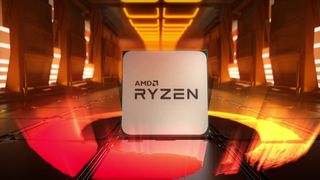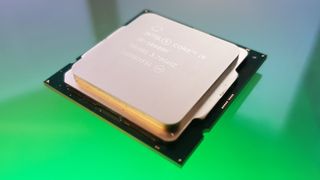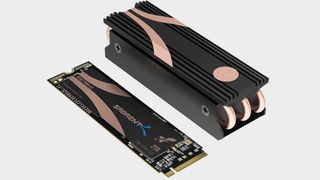Should you upgrade your CPU for top Nvidia Ampere performance?
If you're looking to upgrade your graphics card, then it's worth taking a look at the rest of your system.

I'm sure there are plenty of us that have our sights set on the RTX 3080 or RTX 3070 (or even an RTX 3090) and are already planning what they need to do to give Nvidia's Ampere the best home possible. And it's not necessarily just about throwing as much money as possible at it either, at least it isn't for most of us—those eyeing up the RTX 3090 are obviously in a different league and can head straight for the Intel Core i9 10900K and be done (or the AMD Ryzen 9 3950X if they're feeling a tad contrary).
Nvidia Ampere promises to be a powerful upgrade over Turing (the technology found in the 2080 Ti, 2080 Super, etc.), both in terms of real-time ray tracing but also in more traditional rasterized titles. These new cards are expected to push higher resolutions, with the RTX 3080 designed to game smoothly at 4K, the RTX 3070 covering 1440p comfortably, and the RTX 3090 taking on 8K.
But that isn't all that Ampere has to offer: this is the first Nvidia architecture that supports PCIe 4.0 and it also brings something called RTX I/O to the table, which is a technology based on Microsoft's DirectStorage that will speed up loading within games.
These improvements could lead you to think that you need to upgrade your CPU to get the most from the new tech, but that may not actually be the case. Unless your current PC is very old, there's little chance that your processor will actually really hold back your brand new Ampere graphics card, at least not in any meaningful way.
Your PC platform as a whole should support PCIe 3.0 as a minimum, which means you're looking at anything from the Skylake-era CPUs (6700K, 6600K, etc.) on a 100-series motherboard (Z170, H170, etc.) onwards. You might already have a platform more modern than that, so it may be more a question of upgrading your CPU to futureproof your graphics card purchase as much as possible.
The big question is: do you build around an Intel 10th Gen (Comet Lake) CPU or an AMD Ryzen 3000 (Zen 2) chip? Obviously slightly older generations are still out there, and there are some decent bargains to be had, but given you're looking to upgrade to a brand new GPU, it's reasonable to limit yourself to only the very latest chips.

There's a caveat here though, and it's an important one: AMD's Zen 3 architecture will be here before the year ends. AMD has promised this so many times now, it's almost a meme.
PC Gamer Newsletter
Sign up to get the best content of the week, and great gaming deals, as picked by the editors.
Given AMD's recent successes in processor design, there's the potential that this could be the CPU to hold out for. No one outside of AMD has seen it though, so it's impossible to tell. But, it is something worth bearing in mind, or more practically budgeting for, while you're eyeing up Nvidia's latest. It may just be that you have to hang on to your current system a little while longer until more details emerge.
Now that's out of the way, we can return to the question at hand. AMD Zen 2 or Intel Comet Lake?
Intel has the lead in pure gaming terms with the 10-core, 20-thread Core i9 10900K. It's supposed to be a $500 CPU, although you can expect to pay as much as $800 at the moment, and the accompanying Z490 motherboards can be crazy expensive, but if your interest is gaming and only gaming, then there's a lot to like here if you can stomach the high price.

Slightly lower down Intel's stack the pricing is a bit easier on the wallet, and the drop off in gaming performance is barely noticable, especially at the kind of resolutions that you'll actually want to task your RTX 3080 with. Chips like the 8-core, 16-thread Core i7 10700K ($400) and 6-core, 12 thread Core i5 10600 ($275) are definitely worth considering. You've still got the pricey motherboard conundrum to deal with, but if you're not dead set on overclocking the nuts off your silicon then the B460 motherboards are entirely capable and far more affordable. These lower-end CPUs are decent chips that won't bottleneck your new graphics card. At least not today at any rate.
Alternatively there's the AMD option, which rewards you with plenty of speedy cores. Those who hanker after serious power should probably pick up the Ryzen 9 3900X ($430), which is a 12-core, 24-thread monster with a turbo boost of 4.6GHz. If you don't need so many cores, then the 8-core, 16-thread Ryzen 7 3700X will see you right for a few years, and at $290 it's a decent value proposition too.
There's one thing that Intel's Comet Lake platform doesn't have, and that's support for PCIe 4.0. Even on its latest platform Intel is still stuck supporting PCIe 3.0. And, in case you didn't know, this is one of the benefits of moving over to AMD's Zen 2 architecture. Well, that and the fact that you get more cores for your cash. Gaming performance is slightly lower, but in tests at 1080p you're talking less than a 10 percent difference most of the time, and as you move up in resolution, the difference gets ever narrower.

Until now the main benefit for PCIe 4.0 has been faster storage. With the latest NVMe SSDs you're looking at drives that can hit peak sequential read and writes of around 5,000MB/s, with Samsung's imminent 980 Pro reported to hit 7,000MB/s. This is reason enough for plenty to move over to AMD.
Zen 2 also adds support for PCIe 4.0 graphics cards, although so far there hasn't been much benefit for gamers with the shift. AMD's own RDNA Radeon GPUs (the likes of the Radeon RX 5700XT and 5600) also support PCIe 4.0, but the benefit in gaming is minimal, to say the least.
The new Nvidia Ampere RTX cards are all PCIe 4.0 cards too, but Nvidia has been very up front about the negligible performance improvements this offers. According to Nvidia's own internal testing, the move over to PCIe 4.0 from PCIe 3.0 platform only accounts for about a 1 to 2 percent improvement with current games, although there were applications that saw this hit as much as 10 percent. Overall though, PCIe 4.0 isn't a reason enough in itself to dictate which CPU you should pair with any of Nvidia's Ampere GPUs.
There is something on the horizon that could change that though, and it's something that Nvidia terms RTX I/O. Essentially this is a technology that will see the loading of assets shifted away from the CPU and handled directly by your graphics card. It's based on Microsoft's DirectStorage API, the same thing making the next-gen Xbox Series X a bit damned quick.
There's some cleverness here as well, because your card can handle the compressed data and not have to decompress it first. So not only is it freeing up your CPU to do more important things (and loading data can take up a surprising amount of your CPU's time), but it's more efficient at the same time.

Nvidia showed the technology loading Marbles (that real-time ray traced slither of loveliness that I can't way to play for myself) from a PCIe 4.0 NVMe drive using RTX I/O as opposed to getting the CPU to do all the hard work. You're looking at 1.61 second to load the entire thing using RTX I/O, as opposed to the 5.02 seconds it took a 24-core Threadripper to do the same thing, with every core maxed in the process. And as an aside Nvidia showed the whole thing loading uncompressed from a hard drive too, and that took 62 seconds.
So PCIe 4.0 is potentially going to be important for games. Eventually. There is a bit of a downer here though, and that is because games aren't going to start using this for a while yet. Nvidia isn't releasing the SDK for it until next year, and so probably won't be getting games which utilize it until 2022, and more likely later than that. By which time Intel will definitely have made the switch to PCIe 4.0. It's recently revealed Tiger Lake laptop CPUs already support PCIe 4.0, and its future desktop platform will surely make the shift next year.
So with PCIe 4.0 probably not relevant for a little while yet and the Zen 3 question almost impossible to answer, your choice of processor, as far as we currently know, comes down to what's the best CPU for gaming CPU right now? If you still haven't made your mind up, our guide will answer that very question.
Alan has been writing about PC tech since before 3D graphics cards existed, and still vividly recalls having to fight with MS-DOS just to get games to load. He fondly remembers the killer combo of a Matrox Millenium and 3dfx Voodoo, and seeing Lara Croft in 3D for the first time. He's very glad hardware has advanced as much as it has though, and is particularly happy when putting the latest M.2 NVMe SSDs, AMD processors, and laptops through their paces. He has a long-lasting Magic: The Gathering obsession but limits this to MTG Arena these days.
Most Popular



